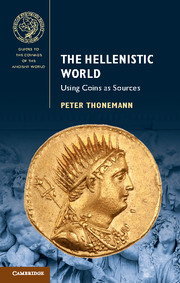Book contents
- Frontmatter
- Contents
- List of maps
- List of figures
- Preface
- List of abbreviations
- Maps
- Part I Globalization
- 1 Alexander and the transformation of Greek coinage
- 2 A ‘big’ Hellenistic world
- Part II Identity
- Part III Political economy
- Part IV Ideology
- Guide to further reading
- Appendices (by Andrew Meadows)
- Bibliography
- Index
2 - A ‘big’ Hellenistic world
from Part I - Globalization
Published online by Cambridge University Press: 05 December 2015
- Frontmatter
- Contents
- List of maps
- List of figures
- Preface
- List of abbreviations
- Maps
- Part I Globalization
- 1 Alexander and the transformation of Greek coinage
- 2 A ‘big’ Hellenistic world
- Part II Identity
- Part III Political economy
- Part IV Ideology
- Guide to further reading
- Appendices (by Andrew Meadows)
- Bibliography
- Index
Summary
Defining the Hellenistic
We all know when Hellenistic history happened: from the death of Alexander in 323 BC down to the death of Cleopatra in 30 BC. Most periodizations in history are pretty arbitrary, and the ‘Hellenistic’ is no exception (Shipley 2000: 1–5). At the lower end, the ‘Hellenistic period’ goes distinctly ragged around the edges: parts of the eastern Mediterranean tend to drop quietly out of Hellenistic history and into Roman Republican history at the point when they become part of the Roman empire (Macedonia in 146 BC, Asia Minor in 129 BC, Syria in 64 BC). Still, we cannot always be talking about ‘the period roughly from the break-up of the Persian empire c. 334–301 BC to the fall of the major Graeco-Macedonian kingdoms c. 146–30 BC’, and – so long as we remember that it is a kind of shorthand – the notion of a Hellenistic period is no worse than most.
But where was the Hellenistic world? This question makes much more of a difference. In practice, historians usually treat the Hellenistic world as roughly co-extensive with the short-lived empire of Alexander: Greece and the southern Balkans, the eastern Mediterranean including Egypt, and western Asia from Turkey and the Levant to Afghanistan and Pakistan. That is to say, the Hellenistic world is usually studied as though it were confined to the various Graeco-Macedonian successor kingdoms and the Greek poleis of Europe and Asia (Walbank 1981; Errington 2008). Regions outside this supposed core zone – the entire western Mediterranean, central and northern Europe, the kingdoms of east and south Arabia – are studied separately, as though they were part of a different world altogether. For most historians, phrases like ‘Hellenistic Gaul’ or ‘Hellenistic Carthage’ feel intuitively just as odd as ‘Renaissance Ethiopia’ or ‘medieval Australia’.
Since the whole idea of a ‘Hellenistic world’ is a modern invention, our intuitions are frankly neither here nor there. A recent book, combatively titled The Hellenistic West (Prag and Quinn 2013), urges us to think through the consequences of regarding the western Mediterranean (including Rome and Carthage) as part of a single, ‘big’ Hellenistic world. Nicholas Purcell has made a case for taking the whole, densely populated zone from Cadiz to Susa, the Mediterranean in the west and the Fertile Crescent in the east, as a single unit of study (Purcell 2013).
- Type
- Chapter
- Information
- The Hellenistic WorldUsing Coins as Sources, pp. 24 - 42Publisher: Cambridge University PressPrint publication year: 2016



